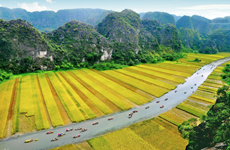Long Bien bridge: Iconic part of Hanoi's history
For generations of Hanoians, the iconic Long Bien Bridge spanning the
Red River has become synonymous with their everyday life, said radio The
Voice of Vietnam (VOV).
For generations of Hanoians, the iconic Long Bien Bridge spanning the
Red River has become synonymous with their everyday life, said radio The
Voice of Vietnam (VOV).
Le Van Minh, 62, who has lived near Long Bien Bridge for years, says he will never forget his childhood when he and his friends used to pass the bridge to go out to Gia Lam District.
"It was back in 1962 when I was just 10 years old. We passed the bridge and went down to the rich alluvial ground of the Hong (Red) River to go fishing and get maize," he recalls.
"After walking along for just several minutes, we felt as if we were living in a world of peace, tranquillity and fresh air. That’s why I still visit the bridge with my grandchildren every day."
Like Minh, many Hanoians living near the bridge say their lives are intrinsically linked to the image of the steel structure that was erected more than 100 years ago.
"We have seen the bridge since we were born and, we have travelled along it our entire lives," says Nguyen Van Thang, a local resident. "For us, it has become heritage in our minds."
Whenever you visit the bridge, you can see crowds of young people taking photos for souvenirs or wedding albums. Foreign visitors like to stroll along the bridge to enjoy the fresh air, and catch a panoramic view of the city.
Recently, the Ministry of Transport proposed three options to modify and modernise this iconic and historic bridge.
The ministry said the rationale behind the plan is to accommodate the rapidly increasing volume of traffic between the districts of Hoan Kiem and Long Bien, situated on either side of the Red River.
The first option is to build a new bridge exactly where the old one stands, keeping the central part with the railway track intact, and moving other sections of the bridge elsewhere for preservation.
The second option is to construct a new, modern bridge of similar design.
The third choice is to modernise the bridge while retaining its central section and the trusses.
The 116-year-old bridge spans three centuries and is considered an important and central part of Hanoi’s development and history.
The steel structure witnessed the withdrawal of French troops from Hanoi and welcomed Vietnamese soldiers to liberate the capital in 1954. It was also severely damaged by fierce American bombardments during wartime.
Professor and Architect Nguyen Viet Chau, Editor-in-chief of Architecture Magazine, notes the bridge has contributed significantly to the economic development of not only Hanoi but also other Red River Delta provinces namely Hai Phong, Hai Duong, and Hung Yen.
The Hanoi – Hai Phong rail route running through Long Bien Bridge enables cargo from Hai Phong to be distributed to localities nationwide.
Long Bien Bridge was designed by world renowned engineer Gustave Eiffel, who was also the designer of the famous Eiffel Tower in Paris. It was constructed between 1899 and 1902 and first opened to traffic in 1903. At the time it was then the only bridge spanning the Red River connecting Hanoi and Hai Phong port city.
"We affirm that, till now, there are no other bridges in Vietnam that have the same history and unique beauty as that of Long Bien," says architect Pham Thanh Tung, from the Vietnam Architects Association.
"Given Hanoi’s rich history and culture, this bridge has huge cultural heritage attached to it that must be respected in line with the Heritage Law," he added.
Historian Professor Le Van Lan says the Long Bien Bridge, along with Mot Cot (One-Pillar) Pagoda and Ho Guom (Sword Lake) represent the cultural and historical significance of Hanoi.
"Only when the bridge was built and put into use, did Hanoi have the opportunity to develop its urban areas on both river banks and form the important economic triangle of Hanoi-Hai Phong–Quang Ninh, that exists today," said Lan.
At a Government meeting on February 28, Prime Minister Nguyen Tan Dung made the crucial decision to preserve the bridge to its original structure and asked the Ministry of Transport and Hanoi to design another railway bridge spanning the Red River to meet the increasing travel demands of local people.
This is excellent news for Hanoians who want to preserve the bridge as part of their emotional and spiritual life.-VNA
Le Van Minh, 62, who has lived near Long Bien Bridge for years, says he will never forget his childhood when he and his friends used to pass the bridge to go out to Gia Lam District.
"It was back in 1962 when I was just 10 years old. We passed the bridge and went down to the rich alluvial ground of the Hong (Red) River to go fishing and get maize," he recalls.
"After walking along for just several minutes, we felt as if we were living in a world of peace, tranquillity and fresh air. That’s why I still visit the bridge with my grandchildren every day."
Like Minh, many Hanoians living near the bridge say their lives are intrinsically linked to the image of the steel structure that was erected more than 100 years ago.
"We have seen the bridge since we were born and, we have travelled along it our entire lives," says Nguyen Van Thang, a local resident. "For us, it has become heritage in our minds."
Whenever you visit the bridge, you can see crowds of young people taking photos for souvenirs or wedding albums. Foreign visitors like to stroll along the bridge to enjoy the fresh air, and catch a panoramic view of the city.
Recently, the Ministry of Transport proposed three options to modify and modernise this iconic and historic bridge.
The ministry said the rationale behind the plan is to accommodate the rapidly increasing volume of traffic between the districts of Hoan Kiem and Long Bien, situated on either side of the Red River.
The first option is to build a new bridge exactly where the old one stands, keeping the central part with the railway track intact, and moving other sections of the bridge elsewhere for preservation.
The second option is to construct a new, modern bridge of similar design.
The third choice is to modernise the bridge while retaining its central section and the trusses.
The 116-year-old bridge spans three centuries and is considered an important and central part of Hanoi’s development and history.
The steel structure witnessed the withdrawal of French troops from Hanoi and welcomed Vietnamese soldiers to liberate the capital in 1954. It was also severely damaged by fierce American bombardments during wartime.
Professor and Architect Nguyen Viet Chau, Editor-in-chief of Architecture Magazine, notes the bridge has contributed significantly to the economic development of not only Hanoi but also other Red River Delta provinces namely Hai Phong, Hai Duong, and Hung Yen.
The Hanoi – Hai Phong rail route running through Long Bien Bridge enables cargo from Hai Phong to be distributed to localities nationwide.
Long Bien Bridge was designed by world renowned engineer Gustave Eiffel, who was also the designer of the famous Eiffel Tower in Paris. It was constructed between 1899 and 1902 and first opened to traffic in 1903. At the time it was then the only bridge spanning the Red River connecting Hanoi and Hai Phong port city.
"We affirm that, till now, there are no other bridges in Vietnam that have the same history and unique beauty as that of Long Bien," says architect Pham Thanh Tung, from the Vietnam Architects Association.
"Given Hanoi’s rich history and culture, this bridge has huge cultural heritage attached to it that must be respected in line with the Heritage Law," he added.
Historian Professor Le Van Lan says the Long Bien Bridge, along with Mot Cot (One-Pillar) Pagoda and Ho Guom (Sword Lake) represent the cultural and historical significance of Hanoi.
"Only when the bridge was built and put into use, did Hanoi have the opportunity to develop its urban areas on both river banks and form the important economic triangle of Hanoi-Hai Phong–Quang Ninh, that exists today," said Lan.
At a Government meeting on February 28, Prime Minister Nguyen Tan Dung made the crucial decision to preserve the bridge to its original structure and asked the Ministry of Transport and Hanoi to design another railway bridge spanning the Red River to meet the increasing travel demands of local people.
This is excellent news for Hanoians who want to preserve the bridge as part of their emotional and spiritual life.-VNA













